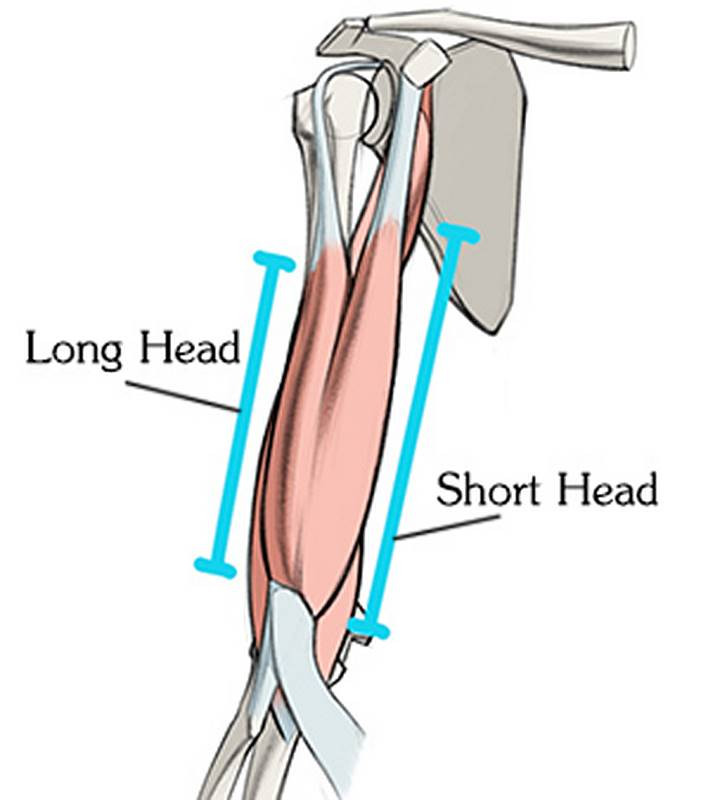Today we’re gonna learn how to draw the biceps and its friend, the brachialis. The brachialis sits under the biceps and helps it bend the elbow.

Brachialis
It originates from the lower half of the humerus, starting right where the deltoid ended.
The brachialis inserts on the coronoid process of the ulna, which is that hook on the front that grips the humerus.
The biceps sit on top of the brachialis, so the brachialis is only visible along the sides of the arm.
It’s kinda like a muscle sandwich where you can only see the brachialis bologna along the edge.


Like all arm muscles there is asymmetry here. The brachialis is higher on the outside and lower on the inside.
The inside view is also softened by the veins, arteries, and nerves that overlap it. So, it’s form is usually larger and more visible on the outside of the arm.
When flexed, it appears as an oval-shaped relief on the sides of the arm.
The brachialis is a really good wingman. It helps the biceps look bigger by pushing them forward a bit. On that note...
Biceps Brachii
It’s time for the superstar of the arms - the biceps brachii! This is a two-headed muscle, as the name tells you, just like the triceps is a three-headed muscle.
So the biceps have both a long head and a short head that you need to know.


The long head originates from the scapula, at the supraglenoid. That’s just at the top of the shoulder joint. Its tendon travels over the head of the humerus and down the bicipital groove. Since, the long head points directly at the head of the humerus, you can use that to locate the head of the humerus when drawing from a model. Keep that in mind during our tracing assignments.
The short head originates from the tip of the coracoid process, Don’t mix it up with the coronoid process of the ulna, where the brachialis inserts. I know, these names were poorly chosen. You just wait, it gets worse.
Both the biceps’ short and long head merge together to make a simple, large, fusiform muscle belly. Which comes to an abrupt end in a tendon that buries itself into the forearm, to insert on the tuberosity of the radius. So, the biceps never directly attach to the humerus. For the upper arm superstar, that’s pretty weird! I also want to point out that the biceps go to the radius, and the brachialis goes to the ulna. Together they pull on the forearm to bend the elbow. The biceps also help supinate the forearm,
Remember how the arm muscles are asymmetric? The biceps run from the shoulder joint to the radius, which creates a diagonal angle.
There’s a couple important differences between the short head and the long head. First of all, the short head is longer.
Ya, the naming is bad. The “short” head muscle belly is higher up on the arm and extends down lower. It’s probably called the short head because it has a shorter tendon. Which is ridiculous.
The biceps are lopsided in the way they’re named and the way they’re shaped. So, keep that in mind when you’re designing them in your drawings. The separation between the long head and short head is sometimes visible at the top, where it comes out from under the pec and deltoid. This is especially noticeable when the arm is straight out. And of course, only when there's little body fat to soften it.
But it also matters if the arm is supinated or pronated. Since the biceps insert on the radius, as the radius pronates away, the biceps are stretched out thinner.
They will look flatter and longer, softly transitioning into the elbow. But when the arm is supinated, the biceps look shorter and fuller.

There’s one last thing to cover. The biceps have an interesting effect on the forearm. A wide, flat tendon branches off from the bottom of the bicep, travels downwards and medially, and attaches to the skin above the forearm flexors. This is a couple inches below the medial epicondyle. This tendon basically acts like a belt strapped around the forearm. When the arm flexes, the forearm muscles are trapped between this tendon and the elbow. So the muscles bulge here and you'll see a dimple. It’s most noticeable when the elbow is at 90 degrees, the forearm is supinated, and the arm muscles are tensed.
For skinny males and most females, the simple form of the biceps is cylindrical. For athletic guys, the biceps can be thought of as a box, with clear top and side planes. Although when the biceps flex, they become shorter and more spherical.

That’s it for now, but look forward to learning all about the triceps in the next lesson.
Coracobrachialis
If you want to learn about the biceps other friend, check out the Premium Anatomy Course.
Assignment: Draw the Biceps
our assignment is to do quicksketch drawings of the upper arm from the model photos I’ve provided below. Start with the gesture then focus on drawing the forms of the muscles. Since we already learned about the deltoid, you can have some fun with those too.















